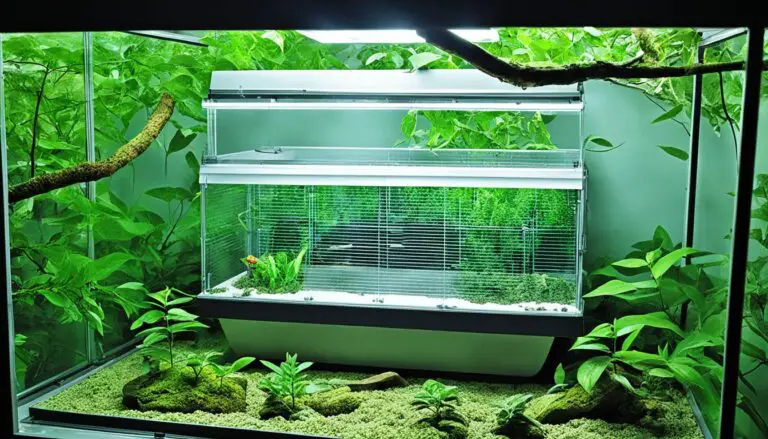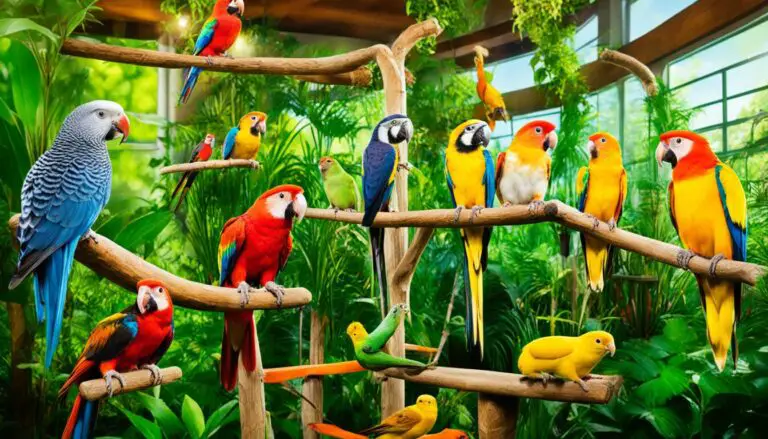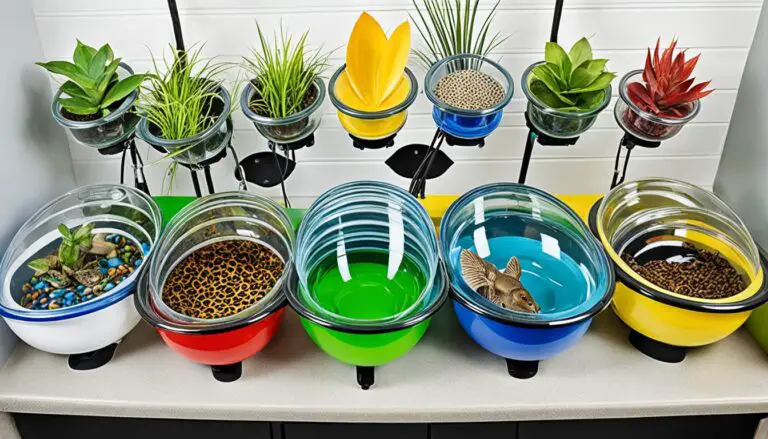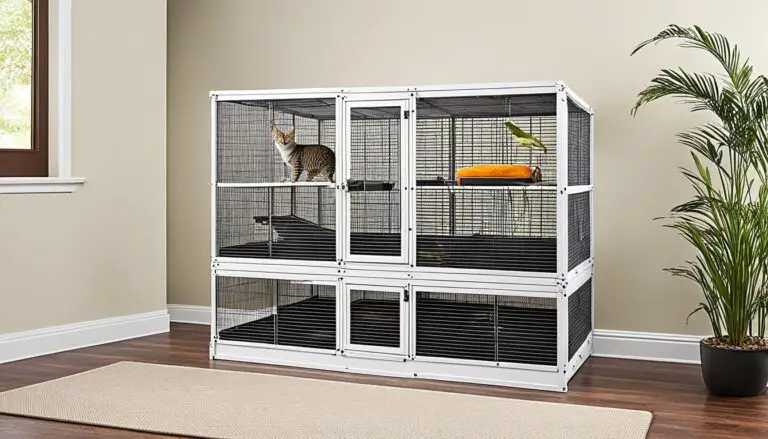Exotic Pet Housing Furniture Essentials + Tips
When it comes to housing exotic pets, providing the right furniture and creating a stimulating environment is crucial for their well-being and happiness. From unique pet enclosures to luxury animal habitats, there are various options available to ensure your exotic pet has a comfortable and enriching living space. In this article, we will explore the essentials of exotic pet housing furniture and provide tips on creating the perfect habitat for your unique companion.
Key Takeaways:
- Understanding the specific requirements of different exotic pet species is essential for providing appropriate housing.
- Creating an enriching environment with decorative items, plants, and toys can stimulate your pet’s mental and physical well-being.
- Each reptile species has unique terrarium requirements, including temperature control, lighting, substrate, and humidity.
- Adequate housing for aquatic turtles, tortoises, bearded dragons, and corn snakes involves specific considerations for their habitat.
- Investing in high-quality exotic pet housing furniture, such as custom enclosures and designer furniture, can provide a luxurious and safe living space for your beloved pet.
Reptile Housing Requirements
Reptiles, like tegus, have specific housing requirements that must be met to ensure their well-being and comfort. When setting up an enclosure for a reptile, such as a reptile enclosure or terrarium, it is essential to consider factors such as temperature control, lighting, sanitation, and habitat preparation.
Temperature Control
Temperature regulation is crucial for reptiles as they are ectothermic creatures and rely on external sources of heat to maintain their body temperature. It is important to provide a temperature gradient within the enclosure, allowing the reptile to move between warmer and cooler areas as needed. This can be achieved by using heat lamps, heat mats, or ceramic heat emitters.
Lighting
Proper lighting is essential for reptiles as it helps maintain their circadian rhythm and provides the necessary UVB radiation for vitamin D synthesis. UVB lighting should be provided for reptiles that require it, such as certain lizard species. Additionally, a day-night cycle should be established to mimic their natural environment.
Sanitation
Maintaining a clean and sanitary habitat is crucial for the health of reptiles. Regular cleaning of the enclosure, including removing waste and uneaten food, helps prevent the buildup of bacteria and parasites. Reptile enclosures should have appropriate substrate that is easy to clean, such as reptile carpet or newspaper.
Habitat Preparation
Prior to bringing a reptile home, the habitat should be fully prepared and secured. This includes ensuring that the enclosure is escape-proof and provides suitable hiding spots and climbing opportunities for the reptile. Water should be provided in a dish or tub for reptiles that require a water source.
| Reptile Housing Requirements: | Highlights: |
|---|---|
| Temperature Control | Provide a temperature gradient within the enclosure. |
| Lighting | Use UVB lighting and establish a day-night cycle. |
| Sanitation | Maintain a clean and sanitary habitat. |
| Habitat Preparation | Ensure the enclosure is fully prepared and secure. |

By meeting the reptile housing requirements, you can create a safe and comfortable environment for your pet reptile. Understanding and fulfilling their specific needs for temperature control, lighting, sanitation, and habitat preparation is crucial for their overall health and well-being.
Enriching the Tegu Enclosure
Tegus, like many other reptiles, thrive in an enriched environment that engages their natural instincts and keeps them mentally stimulated. By incorporating various decorations and providing opportunities for exploration, climbing, and hiding, you can create a comfortable and engaging habitat for your tegu. Let’s explore some essential elements to enhance your tegu’s enclosure:
Decorative Items
Decorative items are not only visually appealing but also provide essential elements for your tegu’s well-being. Consider including the following:
- Tegu enclosure decorations: Add decorations that mimic the natural environment of tegus, such as caves, rocks, and tree stumps.
- Hide box: Place a hide box in the enclosure to provide a safe and secure hiding spot for your tegu.
- Water tub: Create a water tub or pool with enough depth for your tegu to soak and regulate its body temperature.
- Large logs/branches: Incorporate large logs or branches to create climbing opportunities for your tegu.
These decorative items not only add visual interest to the enclosure but also provide opportunities for natural behaviors and enrichment.
Plants and Substrate
Adding live or artificial plants can enhance the visual appeal of the tegu enclosure. However, it is crucial to ensure that the plants are safe and non-toxic. Live plants should be chosen carefully to withstand the tegu’s activity and temperature requirements. Alternatively, artificial plants can provide a low-maintenance and safe option for enrichment.
Thick substrate, such as coconut coir or cypress mulch, can help maintain the proper humidity level and offer a comfortable surface for your tegu to explore and dig. Ensure the substrate is deep enough for burrowing, especially for tegus that enjoy digging in their habitat.
Enrichment Activities
In addition to the physical environment, tegus also require mental stimulation to thrive. Introduce various toys and enrichment activities to keep your tegu entertained and engaged. Consider the following:
- Toys: Puzzle balls, treat-dispensing toys, and foraging puzzles can offer mental challenges for your tegu.
- Rearranging the furniture: Change the layout of the enclosure periodically to provide a new and stimulating environment for your tegu.
Introducing these enrichment activities will prevent boredom, encourage natural behaviors, and promote overall well-being for your tegu.

Terrarium Essentials for Different Reptile Species
Creating the right terrarium setup is crucial for the well-being of different reptile species. Each species has specific terrarium requirements that need to be met to ensure their health and happiness. Here are some essential factors to consider when setting up terrariums for aquatic turtles, tortoises, bearded dragons, corn snakes, and leopard geckos.
Aquatic Turtles
Aquatic turtles require a properly sized terrarium that simulates their natural habitat. A spacious aquarium with a basking area is essential for them to swim and dry off. Maintaining the optimal water temperature is crucial, and an aquarium filter helps keep the water clean and free from harmful pollutants. Regular water maintenance is necessary to provide a healthy environment for aquatic turtles.
Tortoises
Tortoises thrive in terrariums that mimic their natural habitat. It’s important to choose a terrarium size that accommodates the specific tortoise species’ growth. Providing a temperature gradient is essential, with a warm basking spot and a cooler area for them to regulate their body temperature. The terrarium should have suitable substrate to allow burrowing and proper humidity levels to keep the tortoise hydrated.
Bearded Dragons
Bearded dragons need a well-sized terrarium with specific heating and lighting requirements. A proper basking spot with a heat lamp is necessary to provide the right temperature gradient. UVB lighting is crucial for their overall health and bone development. The terrarium substrate should be easy to clean, and proper temperature and humidity regulation are essential to keep them comfortable.
Corn Snakes
Corn snakes require a terrarium that provides security and appropriate temperature and humidity levels. A suitable terrarium size, with hiding spots and climbing branches, allows them to exercise natural behaviors. The substrate should be comfortable, and heat sources need to be provided for proper thermoregulation. Maintaining the right temperature and humidity levels ensures their well-being.
Leopard Geckos
Leopard geckos thrive in a terrarium with specific heating, lighting, and substrate requirements. Providing a suitable temperature gradient with a basking area is essential for their digestion and overall health. Natural-looking substrate such as reptile carpet or sand helps create a comfortable environment. UVB lighting is not essential for leopard geckos but can contribute to their well-being.
When setting up a terrarium for any reptile species, it’s important to consider their unique needs and replicate their natural habitat as closely as possible. Providing the right heating, lighting, substrate, and environmental conditions will help ensure the well-being and happiness of your reptile companion.
Creating the Perfect Aquatic Turtle Habitat
When it comes to providing the ideal environment for your aquatic turtle, there are several key factors to consider. From the size of the aquarium to water maintenance and ensuring a comfortable basking spot, each element plays a crucial role in creating a habitat that promotes the overall well-being of your turtle.

Aquarium Size
The first step in creating an aquatic turtle habitat is selecting the right aquarium size. Aquatic turtles need ample space to swim and explore their surroundings. As a general guideline, provide a minimum of 10 gallons of water for every inch of your turtle’s shell length. However, keep in mind that larger species may require larger tanks to accommodate their size and swimming needs.
Water Maintenance
Regular water maintenance is essential for the health of your aquatic turtle. Cleaning the tank and maintaining proper water quality not only ensures a visually appealing habitat but also prevents the buildup of harmful bacteria that can affect your turtle’s health. Use a filtration system and regularly test the water parameters to ensure optimal conditions for your turtle.
Basking Spot
Aquatic turtles require a dry basking area where they can rest, regulate their body temperature, and receive ultraviolet (UV) light. Providing a basking platform or dock within the aquarium allows your turtle to climb out of the water and soak up the warmth of a basking lamp. The basking spot should be easily accessible and large enough to accommodate your turtle’s body comfortably.
Temperature
Maintaining the correct temperature in your aquatic turtle habitat is crucial for their well-being. A basking light should be installed above the dry area to create a warm spot with a temperature range of 85-95°F (29-35°C). The water temperature should be kept between 75-80°F (24-27°C) to provide a comfortable swimming environment. Use a combination of thermometers to monitor both the air and water temperatures regularly.
Aquarium Filter
An aquarium filter is an essential component of an aquatic turtle habitat. It helps keep the water clean and free from waste, debris, and harmful ammonia levels. Choose a filter that is appropriate for the size of your aquarium and the needs of your turtle species. Regularly clean and maintain the filter to ensure proper functioning and a healthy environment.
By taking the time to create the perfect aquatic turtle habitat, you are providing your pet with a comfortable and stimulating environment where they can thrive. Remember to consider the size of the aquarium, maintain the water quality, provide a basking spot, regulate the temperature, and use an aquarium filter to keep the habitat clean. These factors will contribute to the well-being and happiness of your aquatic turtle.
Providing a Suitable Habitat for Tortoises
Tortoises are fascinating reptiles that require a suitable habitat to thrive. By creating an environment that meets their specific needs, you can ensure their overall health and well-being. Here are some key considerations for providing a proper tortoise habitat:
1. Terrarium Size
The size of the terrarium is crucial for tortoises, as they need ample space to move around and explore. It should be large enough to accommodate the tortoise’s growth and provide plenty of room for activity. The recommended terrarium size will depend on the tortoise species, as different species have varying space requirements. **Terrarium size** should be spacious enough for the tortoise to move comfortably and exhibit natural behaviors.
2. Suitable Substrate
The substrate in the tortoise habitat plays a vital role in maintaining proper hygiene and temperature regulation. Choose a substrate that mimics the tortoise’s natural habitat and allows for burrowing and digging. Some suitable options include coconut coir, cypress mulch, and topsoil. Avoid using substrates that can cause harm if ingested, such as sand or stones. **Substrate** should be carefully selected to promote natural behaviors and prevent any potential health issues.
3. Temperature and Humidity
Tortoises are ectothermic creatures, meaning they rely on external sources to regulate their body temperature. It’s essential to provide a temperature gradient within the terrarium, with a warmer basking area and cooler areas for the tortoise to retreat. The basking spot should have a constant temperature ranging between 85-95°F (29-35°C), while the cooler areas can have temperatures around 75-85°F (24-29°C). Maintain appropriate humidity levels ranging from 40 to 60%. **Temperature and humidity** should be carefully regulated to ensure the tortoise’s comfort and well-being.

“Creating a suitable habitat for your tortoise requires careful consideration of their specific needs. Providing the right terrarium size, suitable substrate, and proper temperature and humidity levels are essential for their overall health and happiness.” – Dr. Sarah Johnson, Herpetologist
4. UVB Lighting
Tortoises need access to UVB light to help metabolize calcium and maintain strong bones and shell health. Ensure to provide a UVB light source within the terrarium, such as a UVB bulb or a UVB-producing lamp. Follow the manufacturer’s instructions for the appropriate distance and duration of exposure to ensure the tortoise receives an adequate amount of UVB radiation.
5. Hiding and Basking Areas
Tortoises require hiding spots within their habitat to feel secure and retreat when they need privacy. You can create hiding spots using rocks or providing artificial shelters. Additionally, include a dedicated basking area where the tortoise can soak up heat and UVB light. This area should have a suitable substrate that allows for easy cleaning and prevents excessive humidity around the basking spot.
6. Diet and Enrichment
Offering a nutritious and varied diet is crucial for the well-being of tortoises. Their diet should consist of a mix of vegetables, fruits, and leafy greens, with appropriate calcium supplements. Additionally, providing enrichment activities, such as foraging toys or puzzle feeders, can keep your tortoise mentally stimulated and prevent boredom.
In summary, providing a suitable habitat for tortoises involves considering factors such as **terrarium size**, **substrate**, **temperature**, and **humidity**. By creating an environment that meets their natural needs, you can ensure a happy and healthy life for your tortoise companion.
Setting Up a Terrarium for Bearded Dragons
Bearded dragons are fascinating reptiles that make excellent pets. To ensure their health and happiness, it’s crucial to set up a well-sized terrarium that meets their specific needs. This section will guide you through the essential terrarium requirements for bearded dragons, including terrarium size, substrate, temperature, and humidity.
Before diving into the specifics, it’s important to note that providing a suitable environment for thermoregulation is vital for bearded dragons. These reptiles require a basking spot that offers them the opportunity to regulate their body temperature according to their needs.
The Bearded Dragon Terrarium Size
The terrarium size for bearded dragons is an important factor to consider. It should be spacious enough to accommodate their natural behaviors and provide ample room for exercise. Experts recommend a minimum terrarium size of 40 gallons for juvenile bearded dragons and at least 75 gallons for adults.
When choosing the terrarium, opt for one with a sturdy glass enclosure and a secure lid to prevent escapes. Bearded dragons are excellent climbers and may attempt to explore beyond the terrarium if given the chance.
Substrate for Bearded Dragon Terrarium
The substrate plays a crucial role in the bearded dragon’s terrarium. It not only provides a comfortable surface for them to walk on but also helps maintain the proper humidity levels. The substrate should be safe, easy to clean, and prevent the risk of impaction.
A popular substrate option for bearded dragons is reptile carpet, which is a washable and reusable material that provides a non-slip surface. Other suitable substrate choices include tile, paper towels, or non-adhesive shelf liner.
Temperature and Humidity Control
Bearded dragons require specific temperature and humidity levels to thrive. The basking area of the terrarium should have a temperature range between 95°F to 105°F (35°C to 40°C), simulating their natural habitat. The cooler side of the terrarium should be maintained at around 80°F (27°C).
Humidity levels should be maintained at around 30% to 40% for bearded dragons. To achieve this, provide a shallow water dish for hydration and periodic misting of the terrarium. However, ensure that the terrarium doesn’t become too humid, as excessive humidity can lead to health issues for these reptiles.
Additional Terrarium Requirements
In addition to the terrarium size, substrate, and temperature control, there are a few other essentials to consider for the bearded dragon’s well-being:
- Proper lighting: Bearded dragons require both UVB and UVA lighting to support their overall health and prevent metabolic bone disease. Ensure you provide a full-spectrum UVB bulb and a heat lamp to create a day-night cycle within the terrarium.
- Decorations and hiding spots: Bearded dragons enjoy exploring their environment. Incorporate rocks, branches, and caves to mimic their natural habitat and provide various hiding spots for them to feel secure.
With these guidelines, you can create a comfortable and enriching terrarium for your bearded dragon. Remember to regularly monitor and maintain the terrarium conditions to ensure your pet’s well-being. Now you’re ready to provide a suitable home for your scaly friend!
| Terrarium Requirements | Details |
|---|---|
| Terrarium Size | Minimum of 40 gallons for juveniles and 75 gallons for adults |
| Substrate | Reptile carpet, tile, paper towels, or non-adhesive shelf liner |
| Temperature | Basking spot: 95°F to 105°F (35°C to 40°C) Cool side: around 80°F (27°C) |
| Humidity | Maintain 30% to 40% humidity |
| Lighting | UVB and heat lamps to create a day-night cycle |
Creating a Corn Snake Enclosure
When it comes to housing a corn snake, providing an appropriate enclosure is crucial for their well-being. Corn snakes are typically kept in terrariums that mimic their natural habitat, offering them a safe and comfortable environment to thrive in.
Terrarium Size: Choosing the right size for your corn snake enclosure is essential. The terrarium should be spacious enough for the snake to move around comfortably and allow for natural behaviors, such as exploring and climbing. As a general guideline, a 20-gallon terrarium is suitable for juvenile corn snakes, while adult snakes will require a larger enclosure, such as a 40-gallon tank.
Substrate: Selecting the appropriate substrate is important for maintaining a clean and healthy enclosure. Aspen bedding or cypress mulch are popular choices for corn snakes, as they provide a natural and absorbent substrate. Avoid using substrates that may cause harm or impaction, such as cedar or pine shavings.
Temperature: Corn snakes are ectothermic reptiles, meaning they rely on external heat sources to regulate their body temperature. It’s essential to provide a temperature gradient within the enclosure, with a warm side and a cooler side. The warm side should be maintained at around 85-88°F (29-31°C), while the cool side should be around 75-80°F (24-27°C).
Humidity: While corn snakes are not particularly sensitive to high humidity levels, maintaining a moderate humidity level between 40-60% is beneficial for their overall health. This can be achieved by providing a humidity hide or misting the enclosure as needed.
Basking Spot: Corn snakes require a designated basking spot where they can elevate their body temperature. A reptile heat mat or an overhead heating lamp can be used to create a warm basking area within the enclosure. Ensure that the basking area reaches a temperature of around 90-92°F (32-33°C).
By carefully considering the terrarium size, substrate, temperature, humidity, and providing a suitable basking spot, you can create an optimal corn snake enclosure that promotes their well-being and allows them to thrive in captivity.
Conclusion
Providing appropriate housing furniture and creating an enriching environment is vital for the well-being of exotic pets. Understanding the specific requirements of different reptile species and implementing proper temperature control, lighting, sanitation, and enrichment can ensure a comfortable and stimulating habitat for these unique companions.
By investing in high-quality exotic pet housing furniture, such as custom enclosures and designer furniture, pet owners can provide a luxurious and safe living space for their beloved pets. These housing essentials not only meet the practical needs of the animals but also add style and aesthetic appeal to any home.
Remember, when it comes to housing exotic pets, attention to detail is key. Research and stay informed about the specific needs of your pet species, and consult with experts or veterinarians if necessary. By following the tips for housing exotic pets and providing them with suitable enclosures, you can create a nurturing environment that promotes their overall health and happiness.
FAQ
What are the essential features of exotic pet housing furniture?
What is the benefit of using custom pet furniture?
How can exotic pet enclosures enhance the well-being of pets?
What are the essential requirements for reptile housing?
How can I create an enriching environment for my tegu?
What are the essential terrarium requirements for different reptile species?
How can I create the perfect aquatic turtle habitat?
What are the essentials for providing a suitable habitat for tortoises?
How should I set up a terrarium for bearded dragons?
What are the essentials for creating a corn snake enclosure?
Source Links
- https://reptifiles.com/colombian-argentine-tegu-care/tegu-enclosure-decor/
- https://www.merckvetmanual.com/all-other-pets/reptiles/providing-a-home-for-a-reptile
- https://www.petsmart.com/learning-center/reptile-care/supplies-youll-need-for-your-reptile-terrarium-setup-|-petsmart/A0004.html
Peter Stones is the founder of Exotic Pets Place, the leading online resource for exotic pet care information.
With over 10 years of hands-on exotic pet ownership experience, he is deeply passionate about sharing his expertise to help others properly care for their unusual pets.
When he's not writing extensively researched articles or connecting with fellow exotic pet enthusiasts worldwide, you can find Peter at home tending to his own beloved menagerie of exotic animals.

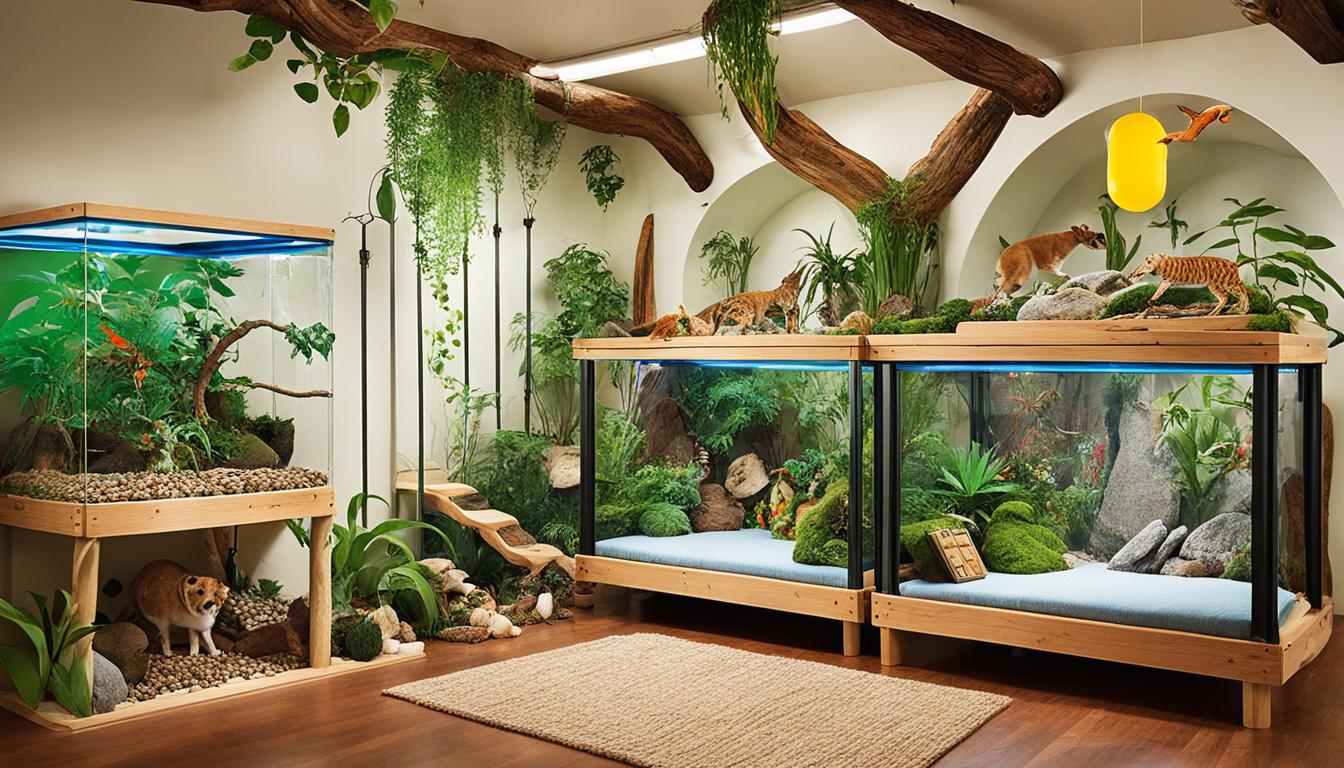
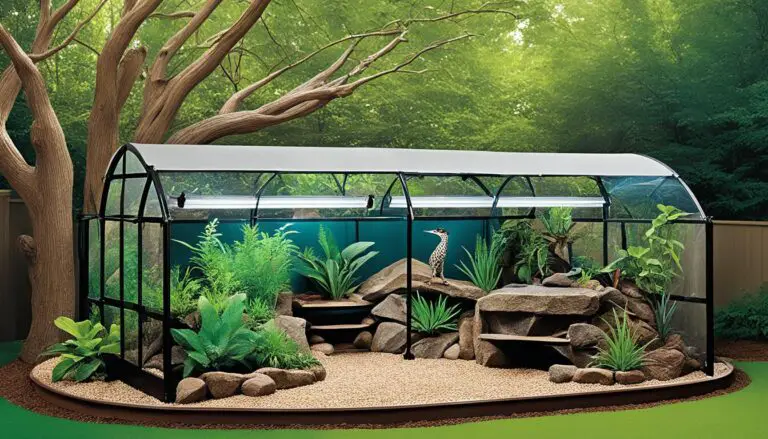
![How to Create a Safe Outdoor Space for Your Exotic Pet [Guide], wood house with a porch](https://exoticpetsplace.com/wp-content/uploads/2023/06/How-to-Create-a-Safe-Outdoor-Space-for-Your-Exotic-Pet-Guide-wood-house-with-a-porch-768x512.jpg)
